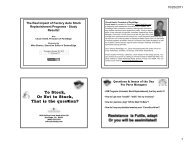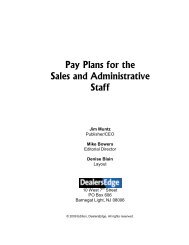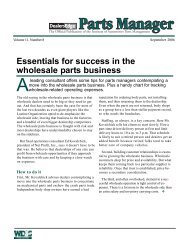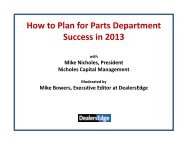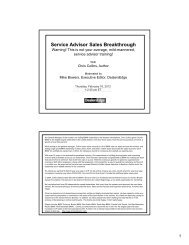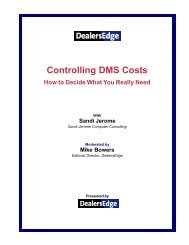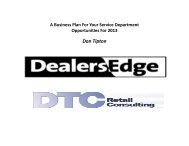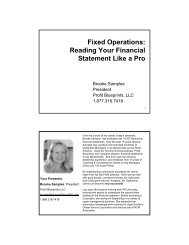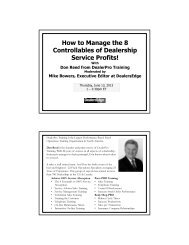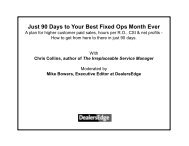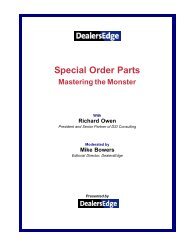How To Avoid Physical Parts Inventory Nightmares - DealersEdge
How To Avoid Physical Parts Inventory Nightmares - DealersEdge
How To Avoid Physical Parts Inventory Nightmares - DealersEdge
Create successful ePaper yourself
Turn your PDF publications into a flip-book with our unique Google optimized e-Paper software.
<strong>How</strong> <strong>To</strong> <strong>Avoid</strong> <strong>Physical</strong> <strong>Parts</strong><strong>Inventory</strong> <strong>Nightmares</strong>WithMark Payne, President & CEO<strong>To</strong>tal Dealer SolutionsModerated ByMike Bowers, Executive Editor<strong>DealersEdge</strong>
Mark Payne, President & CEO of <strong>To</strong>tal Dealer SolutionsMark J. Payne's experience in the automotive industry started very early on. His father, Leo Payne, owned17 car dealerships in the Denver area for over 30 years. Being the visionary that he was, Leo createddealership row, a collection of manufacturers, one right after the other, spanning several city blocks. Leo isstill thought of today as a pioneer in the auto mall concept.Mark grew up in the car business and learned it literally from the ground up. His very first job was to pullthe weeds at his father's dealerships. By the time he got to one end of the dealership, the weeds hadalready begun sprouting back up at the other end. No coward to hard work, his other duties includeddusting the parts bins, helping mechanics clean their tools, emptying grease pans and later serving as a lotrate - moving cars about the lot. He eventually graduated to working in the service, sales and financedepartments where he gained invaluable experience with front end and back end fixed operations.At the ripe age of 10, Mark had made a personal goal to own his own car dealership by the time he was 30.He let his father groom him until it was time to go off to college. Not surprisingly, he attended Michigan'sNorthwood University, a school renowned for its automotive industry based curriculum.Just months before Mark's graduation from the Palm Beach campus, Leo announced the impending sale ofhis dealerships. Mark saw it as a minor setback to achieving his goals but forged ahead, making a namefor himself in the car business, nonetheless. He opened and sold a used car lot in Florida. Then, hemanaged a Honda dealership in South Florida. Under his management, the dealership was catapulted intothe top 2% for sales and customer satisfaction of all Honda dealers nationwide. He returned to Denver forfour years where he started a joint venture with his brother in the telecommunications industry. His share ofthe business generated the revenue necessary to buy his first dealership. Drawn to the sun and sea, hereturned to South Florida working as Sales Manager for Bayview Cadillac, poised to act. After two years,the right opportunity presented itself and, at the age of thirty, he had accomplished his goal as the proudnew owner of Mark Payne Mazda of Miami.In just a few short years, he built up the business and recognized a shift in the industry toward dealershipconsolidation. He then developed and executed his exit strategy and sold for top dollar. After being a dealeroperator and recognizing dealers' lack of knowledge of and emphasis on fixed operations, he decided tobegin consulting & developed products geared towards the fixed ops side. He wanted to highlight theenormous potential for profitability and efficiency as the Fixed Ops Director. Mark J. Payne isPresident/Owner of three distinct yet complimentary companies. Under the Mark J. Payne umbrella are:(1) <strong>To</strong>tal Dealer Solutions, an Automotive <strong>Parts</strong> <strong>Physical</strong> <strong>Inventory</strong> Company (2) Zipcode Target Marketing,a Service Dept Retention & Retrieval Program; and (3) <strong>Parts</strong>fisher, an Automated <strong>Parts</strong> Obsolescene &Redcuction <strong>To</strong>olAlthough he is known for his laid back Colorado style, many people come to find that he is extremelypassionate about his role in the automotive industry. He is a seasoned automotive consultant with decadesof successful front and back end experience to draw from. Mark takes great pride in bringing creativity andingenuity into products that dealers can rely on to make an immediate impact to their bottom line.Mark is a member of many dealer organizations including NADA. His companies are endorsed by manyautomotive organizations and he has been a welcomed guest speaker at several 20 group meetings topromote his products and services.
Mark Payne Presents:HOW TO AVOIDPHYSICAL PARTSINVENTORYNIGHTMARESBest Practices for a Successful <strong>Parts</strong><strong>Physical</strong> Count________________________________________________
Mark Payne -Currently Owner and Presidentof <strong>To</strong>tal Dealer Solutions. Spentover 26 years in all facets of theautomotive business as a SalesManager, <strong>Parts</strong> Manager,Service Manager, GeneralSales Manager, GeneralManager and Dealer Principal.
WHY DO WEDREAD IT?• What do I do?... Its notsomething we do regularly.• If it is an outsidecompany…will they screw upmy inventory?• Will my performance bescrutinized?• Many late nights “gettingready” for inventory• Worries of the unknown ofbeing Over or Short
WHY DO WEDREAD IT?From the Audience• _________________________• _________________________• _________________________• _________________________• _________________________• _________________________• _________________________
Create Your Strategy• Identify your biggest concerns• In-House vs. Outsource• Set your realistic goals• Get your plan in writing brokeninto a three phase approach
Phase1… Pre-<strong>Inventory</strong>• Make up list of tasks and delegate• Set up Pre-inventory meetingswith the GM, controller, partsmanager and service manager.• Walk through the departmentlooking for housekeeping andpotential problems (special orders,claims and returns, NPN’s, binlocations, computer set-up andsatellite parts locations).• Coordinate with Controller on adaily basis
Samples of Pre-<strong>Inventory</strong> Checklistsor reports to run prior to inventory<strong>Parts</strong> Manager-Ten Days Prior to <strong>Inventory</strong>-Complete Cycle Counts 10 days prior using 2302 orINS-Make a map of the parts department with binlocations-Prepare the parts bins/storage area using checklist-Run No Cost Reports 2255 or RNC-Review Negative On Hands 2245 or RNO-Verify all parts have a bin location 2301 or RNB-Locate all App/ Depreciation Reports since lastphysical 2161 or RAD-Determine how special orders will be handled andseparate if needed
Samples of Pre-<strong>Inventory</strong> Checklistsor reports to run prior to inventory<strong>Parts</strong> Manager-cont.Ten Days Prior to <strong>Inventory</strong>-cont.-Organize your dirty cores-Tape off items not to be counted-Identify Obsolescence and remove if possible-Review Open RO/Invoice Reports 3613,6910 orROO-Contact DMS provider and corporate IT to informthem of the date-Verify your log on has access to all the programsyou will need-Test Run your count sheets to verify they areprinting properly
Print Count Sheets2302
Print Count Sheets2302
Print Count Sheets INS
Samples of Pre-<strong>Inventory</strong> Checklistsor Reports to Run Prior to <strong>Inventory</strong><strong>Parts</strong> Manager-cont.Two Days Prior to <strong>Inventory</strong>-Verify all delegated items have been done-Verify all tasks up to this point have been completed-Make sure all parts have been receipted and putaway-Make sure all items are turned into accounting andposted to the GL-Make sure you verify inventory start time with allparties-Be sure you have enough printing supplies on hand
Samples of Pre-<strong>Inventory</strong> Checklistsor Reports to Run Prior to <strong>Inventory</strong><strong>Parts</strong> Manager-cont.One Day Prior to <strong>Inventory</strong>-Ensure all items that need to be posted are turnedinto accounting-Return display items to their respective bin locations-Delete all old list from the system (Reynolds only)-Print Final count sheets-Collect all items necessary for reconciliation-Set up your control desk for collecting count sheets
Samples of Pre-<strong>Inventory</strong> Checklistsor Reports to Run Prior to <strong>Inventory</strong><strong>Parts</strong> Manager-cont.On <strong>Inventory</strong> Day-Arrive one hour before teams show up-Have parts staff dedicated to answering questions-Review Key punch procedures with Keypunchers-Have meeting with all people involved so everyoneknows what to do
Samples of Pre-<strong>Inventory</strong> Checklistsor Reports to Run Prior to <strong>Inventory</strong>Service Manager-Ten Days Before <strong>Inventory</strong>-Be sure to have WIP report clean-Schedule a time during inventory to have carschecked-Be sure to have hat tags displayed not blocking VIN-Start parking all WIP cars together-Get documentation for vehicles not on premise-Be sure to return all dirty cores to parts asap-Identify parts stored in shop that need to be prior toinventory
Samples of Pre-<strong>Inventory</strong> Checklistsor Reports to Run Prior to <strong>Inventory</strong>Service Manager-cont.One Day Before <strong>Inventory</strong>-Ensure all RO’s that need to be closed are closed-Print a final listing of WIP-Turn a copy of final WIP into the Controller-Print a copy of the last repair order opened and turninto controller.
Samples of Pre-<strong>Inventory</strong> Checklistsor Reports to Run Prior to <strong>Inventory</strong>Controller/Office Manager-Ten Days Before <strong>Inventory</strong>-Hold meeting with all parties involved-Verify WIP is being cleaned daily-Verify factory statement is reconciled-Match GLs to Sources for proper reconciliation
Value by Source 2223
Value by Source PH7
Samples of Pre-<strong>Inventory</strong> Checklistsor Reports to Run Prior to <strong>Inventory</strong>Controller/Office Manager-cont.Two Days Before <strong>Inventory</strong>-Verify all paperwork being turned into accounting isbeing postedOne Day Before <strong>Inventory</strong>-Verify that outside purchases are being turned inthroughout the day-Obtain the final WIP from the Service Manager-Once all business is complete for the day ensure theend of dayprocedure will run.On <strong>Inventory</strong> Day-Verify all Ros and Invoices posted properly-Check the WIP with the Service Manager-Print General Ledgers for all parts accounts
Samples of Pre-<strong>Inventory</strong> Checklistsor Reports to Run Prior to <strong>Inventory</strong>CHECKLIST OF PAPERWORK• Copy of Last RO• Copy of Last Counter Ticket• Voided PO after close of business• Copy of WIP including open invoices• Value of General Ledger• Copies of all packing slips of parts receivedbut not invoiced• Copies of all outside purchase packing slipsnot submitted to accounting• Copies of all claims and credits not yetposted to accounting• List of all prepaid parts not yet received• Copies of all appreciation/depreciationreports
Phase 2.. The <strong>Inventory</strong>• Start on time!!• Have count sheets/scannersready day before• Follow every step of theinventory process specific to yourDMS (timing is very critical)• 100% blind count• No count report• Variance report• Perform one count and check allvariances
Phase 2… The <strong>Inventory</strong>• Establish inventory valueincluding WIP, claims andreturns, unpaid invoices, pre-paidspecial orders, manufacturerspacking slips,appreciation/depreciation• <strong>Inventory</strong> operations analysis• Obsolescence analysis
Phase 3... Post <strong>Inventory</strong>• MEETING WITH THECONTROLLER AND THEPARTS MANAGER.• Presentation of the inventorysummary• The parts inventory comparison:Book value versus <strong>Inventory</strong>value• Supporting documents• <strong>Inventory</strong> operations analysis• Observations andrecommendations• Obsolescence Analysis
Is Outsourcing My <strong>Physical</strong><strong>Inventory</strong> Right for OurDealership?Pros vs ConsPros-Bridge the Gap between Accountingand <strong>Parts</strong>-<strong>Parts</strong> inventory value is fullyreconciled with your General Ledger-Knowledgeable second opinion onthe operations of the partsdepartment-An unbiased point-of-view on thelevel of obsolescence and frozencapital
Is Outsourcing My <strong>Physical</strong><strong>Inventory</strong> Right for OurDealership?Pros vs. Cons-cont.Cons-Qualified companies are limited-Can seem costly
Closing Comments andQuestionsThank YouMark Paynemark@markjpayne.com954-410-6368
MONTHDEALERSHIPDATEThis checklist is not copyrighted.It is in the public domain and maybe used at will.www.partsconsulting.comPARTS DEPARTMENT MONTHLY EVALUATION CHECKLIST (v.2010)1. PART NUMBERSCONTROLLED2. TOTAL CONTROLLEDINVENTORY $19. EXCESS STOCK $ / %20. TRUE EXCESS STOCK $ / %LINE 19 MINUS LINE 21 = TRUE EXCESS STOCK3. RECONCILED INVENTORY 21. PARTS > 6 MONTHSNO SALES $(Technical Obsolescence)4. NS PART NUMBERS # / % 22. ALL PARTS > 6 MONTHSNO SALES %5. NON-STOCKDOLLAR VALUE $ / %6. GROSS SALES(Annualized) $7. GROSS PROFIT(Annualized) $8. COST-OF-SALES(Annualized) $9. GROSS PROFITMARGIN %10. INVENTORY F/S $(Actual Cash Value <strong>Inventory</strong> from the General Ledger)23. PARTS > 12 MONTHSNO SALES $(Absolute Obsolescence)24. PARTS > 12 MONTHSNO SALE %25. NEW PARTSNO SALE $(No Movement New) %26. TOTAL DEMAND (Pieces)27. EMERGENCY PURCHASES+CUSTOMER ORDERS (Pieces)28. LOST SALES (Pieces)11. LIFO RESERVE, IF USED $ 29. FILLED FROM STOCK RATIO %Calculated with ‘pieces’12. GROSS TURN RATIO(COS ÷ INV.)30. MONTHS/DAYS OF SUPPLY(F/S INV. ÷ AVG. MO. COS)13. PURCHASE EFFICIENCY (Factory Stock Orders)(Annualized) $14. PURCHASE EFFICIENCY (Other Sources For Stock)(Annualized) $15. PURCHASE EFFICIENCY (Optional, Other Factory)(Annualized) $31.32. NET PROFIT (% of Sales)PARTS DEPARTMENT %33. PERSONNEL EXPENSE(PERS EXP ÷ GP) %16. TOTAL EFFICIENT (<strong>To</strong>tal Lines: 13 thru 15)PURCHASES $17. PURCHASE EFFICIENCY (TEP $ ÷ COS$) TOTALEFFICIENT PURCHASES FOR STOCK18. TRUE TURN(TEP % x GROSS TURN)%34. PRODUCTIVITY(Pieces/Employee/Month)(Dollars/Employee/Month) $35. ABSORPTION RATE = %[GP <strong>Parts</strong>, Service & Body (YTD)(YTD) <strong>To</strong>tal Dealer Fixed Overhead Expense]36. SERVICE EFFICIENCY____________ %You may copy this checklist as necessary
MONTHDEALERSHIPDATEThis checklist is not copyrighted.It is in the public domain and maybe used at will.www.partsconsulting.comPARTS DEPARTMENT MONTHLY EVALUATION CHECKLIST (v.2010)1. PART NUMBERSCONTROLLED2. TOTAL CONTROLLEDINVENTORY $19. EXCESS STOCK $ / %20. TRUE EXCESS STOCK $ / %LINE 19 MINUS LINE 21 = TRUE EXCESS STOCK3. RECONCILED INVENTORY 21. PARTS > 6 MONTHSNO SALES $(Technical Obsolescence)4. NS PART NUMBERS # / % 22. ALL PARTS > 6 MONTHSNO SALES %5. NON-STOCKDOLLAR VALUE $ / %6. GROSS SALES(Annualized) $7. GROSS PROFIT(Annualized) $8. COST-OF-SALES(Annualized) $9. GROSS PROFITMARGIN %10. INVENTORY F/S $(Actual Cash Value <strong>Inventory</strong> from the General Ledger)23. PARTS > 12 MONTHSNO SALES $(Absolute Obsolescence)24. PARTS > 12 MONTHSNO SALE %25. NEW PARTSNO SALE $(No Movement New) %26. TOTAL DEMAND (Pieces)27. EMERGENCY PURCHASES+CUSTOMER ORDERS (Pieces)28. LOST SALES (Pieces)11. LIFO RESERVE, IF USED $ 29. FILLED FROM STOCK RATIO %Calculated with ‘pieces’12. GROSS TURN RATIO(COS ÷ INV.)30. MONTHS/DAYS OF SUPPLY(F/S INV. ÷ AVG. MO. COS)13. PURCHASE EFFICIENCY (Factory Stock Orders)(Annualized) $14. PURCHASE EFFICIENCY (Other Sources For Stock)(Annualized) $15. PURCHASE EFFICIENCY (Optional, Other Factory)(Annualized) $31.32. NET PROFIT (% of Sales)PARTS DEPARTMENT %33. PERSONNEL EXPENSE(PERS EXP ÷ GP) %16. TOTAL EFFICIENT (<strong>To</strong>tal Lines: 13 thru 15)PURCHASES $17. PURCHASE EFFICIENCY (TEP $ ÷ COS$) TOTALEFFICIENT PURCHASES FOR STOCK18. TRUE TURN(TEP % x GROSS TURN)%34. PRODUCTIVITY(Pieces/Employee/Month)(Dollars/Employee/Month) $35. ABSORPTION RATE = %[GP <strong>Parts</strong>, Service & Body (YTD)(YTD) <strong>To</strong>tal Dealer Fixed Overhead Expense]36. SERVICE PROFICIENCY___________ %You may copy this checklist as necessary
MONTHDEALERSHIPDATEThis checklist is not copyrighted.It is in the public domain and maybe used at will.PARTS DEPARTMENT MONTHLY EVALUATION CHECKLIST (v.2010)1. PART NUMBERSCONTROLLED2. TOTAL CONTROLLEDINVENTORY $19. EXCESS STOCK $ / %20. TRUE EXCESS STOCK $ / %LINE 19 MINUS LINE 21 = TRUE EXCESS STOCK3. RECONCILED INVENTORY 21. PARTS > 6 MONTHSNO SALES $(Technical Obsolescence)4. NS PART NUMBERS # / % 22. ALL PARTS > 6 MONTHSNO SALES %5. NON-STOCKDOLLAR VALUE $ / %6. GROSS SALES(Annualized) $7. GROSS PROFIT(Annualized) $8. COST-OF-SALES(Annualized) $9. GROSS PROFITMARGIN %10. INVENTORY F/S $(Actual Cash Value <strong>Inventory</strong> – General Ledger)23. PARTS > 12 MONTHSNO SALES $(Absolute Obsolescence)24. PARTS > 12 MONTHSNO SALE %25. NEW PARTSNO SALE $(No Movement New) %26. TOTAL DEMAND (Pieces)27. EMERGENCY PURCHASES/CUSTOMER ORDERS (Pieces)28. LOST SALES (Pieces)11. LIFO RESERVE, IF USED $ 29. FILLED FROM STOCK RATIO %Calculated with ‘pieces’12. GROSS TURN RATIO(COS ÷ INV.)30. MONTHS/DAYS OF SUPPLY(F/S INV. ÷ AVG. MO. COS)13. PURCHASE EFFICIENCY (Factory Stock Orders)(Annualized) $14. PURCHASE EFFICIENCY (Other Sources For Stock)(Annualized) $15. PURCHASE EFFICIENCY (Optional, Other Factory)(Annualized) $16. TOTAL EFFICIENT (<strong>To</strong>tal Lines: 13 thru 15)PURCHASES $17. PURCHASING PERFORMANCE (TEP $ ÷ COS)TOTAL PURCHASES FOR STOCK18. TRUE TURN(SOP % x GROSS TURN)%31.32. NET PROFIT (% of Sales)PARTS DEPARTMENT %33. PERSONNEL EXPENSE(PERS EXP ÷ GP) %34. PRODUCTIVITY(Pieces/Employee/Month)(Dollars/Employee/Month) $35. ABSORPTION RATE = %[GP <strong>Parts</strong>, Service & Body (YTD)(YTD) <strong>To</strong>tal Dealer Fixed Overhead Expense]36. SERVICE PROFICIENCY %You may copy this checklist as necessary1
INTERPRETIVE KEY TO v. 2010 MONTHLY CHECKLISTUpdated VersionThis new version, v2010, is a final compilation of many changes both in the data being analyzedand the sources of that data. It includes some additions of data that are essential to goodinventory management. It has deleted some data that is no longer effective or that has beenreplaced by a measurement that is more precise or defining of the efficiency and productivityand profitability of the parts department.The most important addition is a measurement from the service department, the prime customerof the parts department and the ‘face’ of CSI to the marketplace; it is ‘service efficiency’ thatreally defines how well the parts department has ‘fed’ the technicians who in turn move the carsinto and out of the service department.This monthly checklist is a summary of important interpretive data for the Dealer, GeneralManager and <strong>Parts</strong> Manager. It is intended to be produced at the end of each month with datataken from four sources, along with some calculations, that should be reviewed by theDealer/General Manager and <strong>Parts</strong> Manager.This version has also been re-sequenced to reflect the additions and/or deletions of data.The information is derived from the following sources:1. The dealership financial statement;2. The monthly summary data from the computer system (or the same information takenfrom report generators);3. Specific purchase information⎯usually available from the Factory. Included in this isadditional information taken from the accounts payable records from the detailed generalledger;4. Specialized information from the DMS system (the accessibility of this information willvary from system to system);5. Calculations comparing different pieces of data to each other to achieve numbers uponwhich management decisions will/should be made.This summary is intended to be just that⎯a summary⎯and not an all inclusive discussion ofthe background and source of the numbers. The detailed information is found in great detail inthe Manuals produced by Nicholes Capital Management and is available from the company.A new version of the manual, accommodating this newer checklist is also available. <strong>To</strong> get moredetailed information go to www.partsconsulting.com.1. Part Numbers Controlled. These are the part number records in the computer systems thatare monitored by the system for sales activity and other information. This number representsonly those numbers placed in the computer system by the parts manager⎯at the time ofdemand. Not all of these numbers are considered part of the physical stock on hand, but rathera list of all part numbers that have been requested, or inquired about, from the partsdepartment.2. <strong>To</strong>tal Controlled <strong>Inventory</strong> Value (Replacement value currently stocked and shown in theDMS system). This number represents the cost of the part currently shown on the master tapeof the manufacturer. It is updated frequently and represents the ‘replacement value’ of theinventory on the shelf⎯not necessarily the amount paid for the parts. A comparison between2
line #3, the reconciled inventory and line #10, the figure from the financial statement, will andshould be made continuously.3. Reconciled <strong>Inventory</strong>. This figure is similar to that seen at the completion of an annualphysical inventory. It does not necessarily replace a physical inventory (but could do so understringent conditions) but is a monthly check and reconciliation of all parts (value) that are now inlimbo - such as work in process, overlapping billings/receipts, etc. It is this figure that should becompared monthly, with line #10, the figure for inventory from the general ledger. This figureand the G/L figure should not vary more than 1-2% of each other on a monthly basis. See the‘Reconciliation Sheet’ at the end of this summary.4. Non-Stock Part Numbers and the percentage (%) of them carried in the system show thenumber and percentage of part number demand that is being tracked by the system, but are notyet active. Most of these should not have (in theory) an on-hand value. The use of this feature ina computer system is, in the opinion of the writer, second only in importance to the production ofa stock order. The feature enables the parts department to pre-test every number that presentsitself at the counters or on the phone with the possibility of stocking the number once sufficientdemand has been established. The guideline for this figure is 50% + line #1.5. Non-Stock Dollar Value [A PRIME NUMBER FOR EVALUATION] shows the value of thoseparts that are being carried on an NS or Non-stock status in the system that also have an onhandvalue. This process is also called ‘Watch’ in some DMS systems⎯the application andtheory are the same. In theory, the on-hand value of non-stock numbers should be zero. Inpractice there are some cases where an on-hand value is justified⎯such as special orders thathave not yet been picked up by the customer or recommended stocking guides for new modelsthat the manufacturer is suggesting be stocked to the shelf before any actual demand has takenplace. The guideline for this figure is
9. Gross Profit Margin is expressed as a percentage and is calculated by dividing the grossprofit by the gross sales. The range of the gross profit margin, in an average partsdepartment, is 28-35%. <strong>How</strong>ever, before any judgment can be made on the gross margin inthe parts department a detailed analysis of the selling gross profit, by sales type, and theaccompanying percentage of business in that type must be made. If a parts department wereheavy in wholesale (if 40% or more of the total sales are wholesale) then it would be common tosee a lower overall margin. If the parts department had policies using a matrix or changed themargin in sales to the new car department, body shop, mechanical shop, wholesale or frontretail counter⎯these also could reflect in the overall margin. Before any analysis of the marginis done, review the sales by sales type chart first. A judgment of this figure is also done beforeany transfer to another department.10. <strong>Inventory</strong> (Financial Statement) also called an “actual cash value of the inventory” istaken from the financial statement for the month being analyzed. In the case of dealershipsusing LIFO accounting in the parts department, the LIFO reserve should be noted on line #11and included in the number shown on line #10. The ratio between line #3 reconciled inventoryand line #10, the G/L inventory, is considered A PRIME NUMBER FOR EVALUATION.11. LIFO reserve, if any, is noted on line #11. Again, it is important in reviewing the partsdepartment that the inventory before any accounting adjustment such as LIFO is done. There isno guide, nor opinion offered, on the use of this method of accounting and it left totally to thedecision of the dealer principle and the accountants if it is to be used.12. Gross Turn Ratio is referred to by many other names (such as: turn, dollar turn, raw turn,or simply gross turn). It is however a ratio and does not define or truly measure the number oftimes the dealerships parts investment turned relative to purchases. This figure is one of theoldest in use in the automotive and heavy duty truck industries, and many other similarindustries. It is a ratio between dollars bought (cost-of-sales) and dollars stocked (inventoryvalue on the shelf). It does not tell the dealer, or anyone else for that matter, the true efficiencyof the investment - that is done with other calculations. As a rough guideline the following isoffered:- for dealers on a daily stock orders (for over two years): 5-7- for dealers on a weekly stock orders: 4-613-16. These lines are shaded together because of the relationship they have with each other.Four lines are given on this generic checklist - three could be used and the number could beexpanded for multiple line dealerships if desired. These lines measure the purchases (bought‘smart’ or efficiently) are referred to as purchases for stock from three distinct sources. Thisarea of measurement was called stock order performance for many decades until it wasdiscovered and clarified that the parts manager had three different types and sources ofpurchasing, all three of which could be accurately deemed as wise, efficient or ‘smart’purchases, yet were technically not stock orders. The designation of this category of evaluationto Purchase Efficiency was begun in 1998 and continues to the current day.13. Purchase Efficiency [annualized] (daily or weekly or ‘RIM’ stock orders from themanufacturer annualized) are those parts purchased or acquired on the programs in place bythe manufacturer that affords the highest eventual profitability to the parts department when theparts are sold. These purchases often include, but are not limited to, discounts, obsolescencereturn credits, free freight, etc. The most important aspect of this category is that the parts,when needed by the customer, especially the technician, are available on demand thusincreasing the efficiency and profitability of the technician. The source of this information is fromthe manufacturer. Some manufacturers make this data readily available and easy to obtain (afew do not however). This category is one of three that will be used, in connection with apurchase efficiency guideline, in the parts department.4
14. Purchase Efficiency. [Annualized] <strong>Parts</strong> purchased from outside jobbers and suppliers forstock and on a regular basis. These parts also use sales history as do the parts purchasedfrom the manufacturer on regular, daily or weekly, or ‘RIM’ stock orders. This is often not apopular category with the manufacturer, but it is, nonetheless, an efficient purchase made bythe parts manager which, in return for increased discounts or availability, afford the user instantavailability (the technicians) and thus increase the efficiency in the service department in thedealership. This category is one of three that will be used, in connection with a purchaseefficiency guideline, in the parts department.15. Purchase Efficiency: [annualized] foreign parts purchased by the parts department andprocessed through the accounting functions that are for parts ‘foreign’ to those lines of productcarried by the franchised dealership. These parts, although not purchased on a stock order inthe same fashion as lines #12 and #13, are usually purchased only ‘as needed,’ which could bemisconstrued as an emergency purchase. For posting purposes, they are ‘emergency receiptsor purchases’. The purchase of this category of parts increases the cost-of-sales and affects thegross margin and gross sales in the parts department. In this category, the parts manager didnot have an option of stock order or not and purchased what was necessary, when it wasnecessary, to fill the need of the mechanical shop or body shop. Because these parts areprocessed (in a sales function) as all the others and because the parts manager had nopurchase option, they are deemed to have been purchased “as efficiently as possible” and aretherefore included in the analysis.<strong>To</strong> omit these purchases, which could be very large in the case of the dealership having a bodyshop, would be to dilute the end numbers severely and improperly reflect poor purchasingefficiency when just the opposite is the case. This category is one of the three that will be used,in connection with a purchase efficiency guideline, in the parts department.16. <strong>To</strong>tal Efficient Purchases or Purchases for Stock (Dollar totals from lines 13-15)designate the total dollar amount that the part department purchased in such a way as to bedeemed efficient purchases which, in turn, increased the efficiency of other departments - suchas the mechanical and body shops. No guide is given here for this number; it is used in thecalculation of <strong>To</strong>tal Purchase Efficiency on line #18.17. Purchasing Performance (in the past used to be called stock order performance)⎯adesignation abandoned in the early 1990’s with the advent of daily stock orders) is thepercentage of cost-of-sales (line #8) that were purchased in a manner that gave the highestgross profit margin and offered the customer instant, or near instant, availability.Formula: <strong>To</strong>tal efficient purchases on line #16 divided by the annualized cost-of-sales on line#8.Guidelines vary based on whether the parts department is on a daily or weekly stock or ‘RIM’order.[A PRIME NUMBER FOR EVALUATION]- “RIM’ replenishment order up to 94%- Daily stock order: 85-90%- Weekly stock order: 80-88%In the case of manufacturers using ASR or RIM (automatic stock replenishment or Retail<strong>Inventory</strong> Management) which was pioneered by Saturn, this number will be significantly higherthan those departments that have to ‘place’ a daily or weekly stock orders.5
18. True Turn [A PRIME NUMBER FOR EVALUATION] is one of the four strongestdesignators of efficiency and profitability for the parts department. The measurement is to takethe gross turn ratio (line #12) and multiply it by the total purchase efficiency (Line #17)(don’t forget to move the decimal when doing the conversion from percentage to multiplier). Thedesired figure for this calculation is heavily influenced by the frequency of stock order⎯daily,RIM, or weekly⎯and the level of total purchase efficiency. The desired results are as follows:- daily stock orders: 5-7 true turns per year- weekly stock orders: 3-5 true turns per year- ASR or RIM will often exceed 9 true turns per year19. <strong>To</strong>tal Excess Stock is a calculation that tells the dealer and parts manager the total dollaramount of inventory that ‘is in excess’ of the current calculated buying guides. The formula is asfollows:On Hand + Back Orders + Outstanding Orders > Max/BSL/High GuideIt should be noted that before any definitive decision or conclusion is made based on thisnumber that the following rule should be observed:All obsolescence is excess, but not all excess is obsoleteSome computer systems have these reports ‘built into’ the user programs, while others need touse a report generator to obtain the report. The total value of the report should be the amountthat is ‘in excess’ and not the on-hand value of the part number. Unfortunately, this error isfound in one major system.The general guide, and this should be a ‘trended’ guide, for total excess stock is
24. Percentage of parts over 12 months no sales. Guidelines for line #23 are as follows:Daily Stock order systems:
27. Emergency Purchases or Receipts + Customer Special Orders. This figure represents aslightly different approach than calculations used in the past. Here we are adding customerorders that were placed on the stock order (smart move by the parts manager) yet representhybrid emergency purchases. There is a fine line drawn here in that many of the DMS systemsallow a variety of receipt and posting codes for parts that are, by definition, emergencypurchases. The fact that a daily stock order exists allows the parts manager to put these on thestock order. They are not for stock, but for a specified customer; they are a hybrid emergencyreceipt or purchase.A loose guide would be that less than 10-15% of all orders should be emergency orcustomer special orders.The piece count of emergency receipts and customer special orders is used for the FOScalculation on line 29.28. Lost Sales demand is one of the most critical pieces of information the system needs inorder to calculate suggested orders more accurately, within the established buying guides, andto monitor testing parts that might, eventually, need to be actively stocked to the shelves.A lost sale is a demand, from anyone, that does not result, at the time of demand, in a sale ofthe part; the customer leaves or hangs up the phone and that specific transaction is ended.Despite the reasons for the lost sales, all of them must be posted to the system.There are three types of lost sales demand. Two of these types can be tracked and posted inthe parts department, at the time of demand. The third type of lost sales is still a problem formost DMS systems and Factory Distribution Systems since it represents untraceable demanddone electronically without leaving a trail of the demand in the parts department. The threetypes of lost sales are:1. Lost sale based on availability⎯over all the most frequent type.2. Lost sales on the cost of the part⎯customer hangs up and goes elsewhere3. Electronic locator systems⎯demand from others that leaves no trail of thedemandIt is critical that all parts personnel that talk with the customer on the phone or at the counters betrained to post all lost sales. In the calculation for FOS the pieces lost is used.The guidelines here are from two databases. One is from a database of over 10,500 dealerrecords and represents an average of lost sales posted per person per day; it is: 2-3/person/day. Average is not much good here because it does not designate what is possiblewhen careful attention is paid to the posting and recording of lost sales.From a ‘select database’ of 105 dealers who, by observation, do the job nearly 100%, the rate is5-8 /person/day. The more accurate guideline is simply to post all lost sales. Remember: It isnot the existence of lost sales that is a problem; it is the absence of lost sales that shouldconcern the managers of the dealership.29. Filled from Stock Ratio - also called Fill-off-the-shelf (FOS) has become the mostaccurate formula for measuring the effectiveness of the parts inventory in satisfying the demandof the technicians and customers, on demand, thus making the technicians more efficient andprofitable and increasing the customer service satisfaction measurements in the dealership.Unlike the older level of service calculation, the calculation for FOS adds an additional piece inthe formula and uses pieces and not part numbers or dollars. The formula is as follows:Fill off the Shelf = <strong>To</strong>tal Demand – [(Lost Sales) + (Emergency Purchases & Special Orders)]8
<strong>To</strong>tal DemandThe guideline for FOS is 85-94%. These rather high figures can only be obtained by using thefollowing controls in the system completely and accurately:FOS IS A PRIME NUMBER FOR EVALUATION1. The correct calculation of the buying guides2. Economic Order Quantity guides3. (Beyond EOQ)⎯the use of minimum stocking levels for certain groups of parts4. Complete posting of lost sales5. Complete posting of emergency receipts and customer special ordersIf all of these criteria are utilized in the parts ordering formulas, an increased rate of fill off theshelf can and will be achieved in the parts department, and the result will be an increase ofservice efficiency (flagged hours/technician/day) and the profit that goes with it.30. Months/Days of Supply is a calculation in use by most manufacturers, accountants, banks,twenty-groups and others which is really a ratio and not an indicator of the real value oreffectiveness of the investment. This measurement is included on this checklist because it hasan inverse relationship with true turn. As months of supply go down, true turn goes up. Thismakes this calculation a corroborating calculation only.This calculation is, in the opinion of the writer, a potentially dangerous calculation ifused alone. A better evaluation of the ‘quality’ of the inventory in doing the job would belines 17, 18, 29 and 36.For instance: to say that a dealer has a 1.5 months of supply does not mean that the dealershipcan stay in the parts business for 45 days in the absence of resupply, but is only a ratio ofdollars stocked (inventory value) to dollars purchased (cost of sales). The formula is:31. Rate of change is no longer used.<strong>Inventory</strong> (from the financial statement)Average monthly cost of sales32. Net Profit is defined in one of two formulas. While the classical formula used by almost allbusiness schools and manufacturers is to define this as a retained percentage of gross sales, afew manufacturers define the net profit as a percentage of gross profit. The formula used doesnot change the ‘bottom line dollars’ but does have a different percentage to brag about. Thetwo formulas are as follows:Net Profit = Bottom line (annualized) net profitAnnualized Gross SalesOrNet Profit = bottom line (annualized net profitAnnualized gross profitThe guideline based on gross sales is 8 – 15%The guideline based on gross profit is 15-30%It is a reality that two things must be considered before making a decision whether or not theparts department is really profitable:9
1. The parts department does not have total control over all allocated expenses2. The parts department must carefully evaluate the percentage of sales and the specificmargins in all five (or six, if a body shop exists) of the sales types and the percentage ofsales in each type.33. Personnel Expense is a formula that calculates the total cost (annualized or year-to-date)of all the personnel working in the parts department. We do not include those in otherdepartments that contribute to the overall operations of the department and/or the dealership,but only those in the parts department. Many average guidelines are given by manyorganizations. Typically these organizations take the best of a group (such as 20 groups) thatare, by definition, better operations and make the averages from them. In addition, thegeographical differences in personnel expenses, which can range from a low in some states of25% to a tolerable ‘high’ of 60% in other states, demands that this figure be examined only for adealers specific marketplace and not for the nation as a whole. For instance, the existence ofunion vs. non-union shops can also be a prime factor is some of the differences. Nationalaverage is about 40-45%.34. Productivity is defined in two different areas: as the dollar amount of business, on theaverage, that parts personnel are producing on a monthly/yearly basis and as the pieces perperson per month that are ‘moved’ across the counters. Some argue that we should only look atthose who are selling parts: counter personnel, wholesale, etc. The reality is that it takes thewhole team to stock, handle, ship and sell the parts. So this author uses all those in the partsdepartment from the parts manager to the stock pickers and delivery personnel in the formula.The formula is as follows:<strong>To</strong>tal number of parts sales dollars person<strong>To</strong>tal Sales (Line 6) divided by 12 divided by # parts Personnel<strong>To</strong>tal number of pieces sold per person<strong>To</strong>tal Demand (Line 26)The guideline varies on whether there is ‘heavy wholesale’ (>40% of total sales in wholesale)and is not applicable to parts departments with 3 or fewer personnel. In the smaller operationswe fall into a ‘minimal operations’ reality that is not given to the standard guide. Normalguideline for ‘dollars’: $30,000-$38,000/person/month. The guideline for pieces per man permonth will vary by factory type and mixture of sales types. Each parts department shouldestablish the piece calculation for themselves using a trend analysis sheet.35. Absorption Rate is often called the holy grail of the dealership. It defines how much of thetotal fixed operating overhead (cost of turning the key in the door) that is paid by the profits ofthe fixed operations (Service, <strong>Parts</strong> & Body shop). The calculation is as follows:<strong>To</strong>tal Fixed Overhead expense (annualized) (no not include variable selling expense)Annualized gross profits from Service, <strong>Parts</strong> & Body ShopNational averages vary from 55-65%. The rate is 9-15% higher for stores with a body shop. Ifthe parts department can ‘feed’ the technicians efficiently and profitably in the service and bodyshop then this figure will increase through the increased efficiency of service and body. Thegoal is, of course, 100% but that will probably not ever be realized for most dealerships. Themore realistic goal is to get the absorption rate as high as possible, and parts availability playsan integral part in the formula and process.36. Proficiency (Service Productivity) is a new addition to the parts checklist. It has beendemonstrated that an increase in the efficiency of parts fill to technicians, while it might havean accompanying increase in inventory, is manifested not in the parts department but in the10
fill to technicians, on demand, in the service department. This guideline varies a bit, but thebasic formula is:Flagged or billed Flat Rate Hours (varies by month)Clock Hours for the TechniciansThe goal is to exceed 100% (125+% is achievable). Other factors such as stalls/technicianratios can also affect this guide. <strong>Parts</strong> availability, the availability of customers and the space torepair the vehicles all play a role in this most important measurement.[SERVICE PROFICIENCY IS A PRIME NUMBER FOR EVALUATION]Note: Other measurements can be added to the checklist as the dealership becomes moreskilled in the measurement process. The most important thing is to realize that one month is a‘Polaroid’ snapshot of a horse race. The monthly checklist, while valuable, only tells us wherewe are right now. When the monthly data is taken and trended on an Excel spreadsheet, thedirection of the trend is infinitely more important than a single month.When we deal in generalities we will never succeed.When we deal is specifics we will seldom fail.Where performance is measured, performance improves.Where performance is measured and reported, the rateOf improvement accelerates.Thomas Monson11
Monthly <strong>Parts</strong> <strong>Inventory</strong> ReconciliationMonth____________________________ Date_________________________________1. Dollar Value per DMS (replacement Value) $_________________2. Dollar value of non-computer controlled parts $_________________3. Dollar value of parts on Repair Orders $_________________4. Dollar value of core charges (DMS system) $_________________5. Dollar value of defective core charges $_________________6. Dollar value of damaged parts claims $_________________7. Dollar value of pending credits (returns, cores, etc.) $_________________8. Adjusted dollar value of parts department <strong>Inventory</strong> $_________________9. Dollar value of general ledger (actual case value) $_________________10. Dollar value of appreciation/depreciation due toprice changes$_________________11. Dollar value of handling charges, C.O.D., specialdiscounts, etc.$_________________12. Negative on hand and plus/minus adjustments $_________________13. Items invoiced not received, dollar amount ofunrecorded payables, etc.$_________________14. Dollar amount of accounts payable reconciling items $_________________15. Adjusted dollar value of parts general ledgerinventory$_________________16. Dollar value of parts difference – Over+/(Short) $_________________17. Revised dollar value of parts general ledger inventory $_________________In practice, Line 8 should equal line 15 or be within +/- 2%
Month<strong>To</strong> be completed by <strong>Parts</strong> ManagerDealership Sandy Chevrolet June 09Inv per parts management reportSpec/NPN - not in computerNew Cores - not in computer totalsDirty Cores - not in computerWIP - Repair ordersWIP - <strong>Parts</strong> TicketsAppreciation not taken by accountingReturns - no credit received yetNuts/BoltsOther - describe $-Invoices posted not given to AcctPack Slips posted not given to Acct<strong>To</strong>tal $-<strong>To</strong> be completed by Accounting ManagerGL Account# 1 ______ (example 242)(YTD)GL Account# 2 ______ (example 242A)(YTD)Appreciation not booked $-Accounting Invoices not postedAccounting Credits not posted<strong>Parts</strong> Invoices/Pack Slips not in office $ -<strong>To</strong>tal Per GLDifference (shortage) $-Variance#DIV/0!Source - Sandi Jeromewww.sandijerome.com



